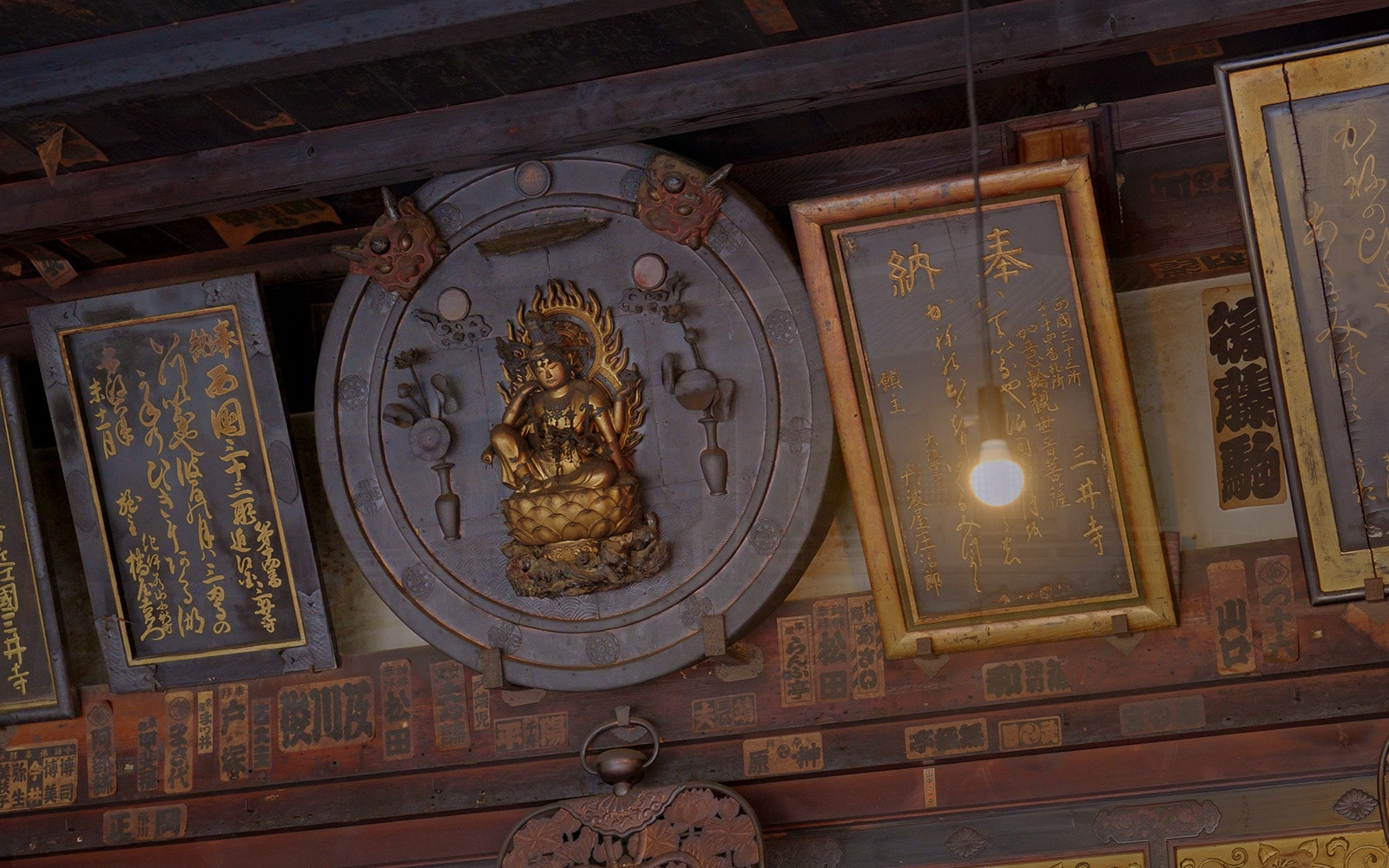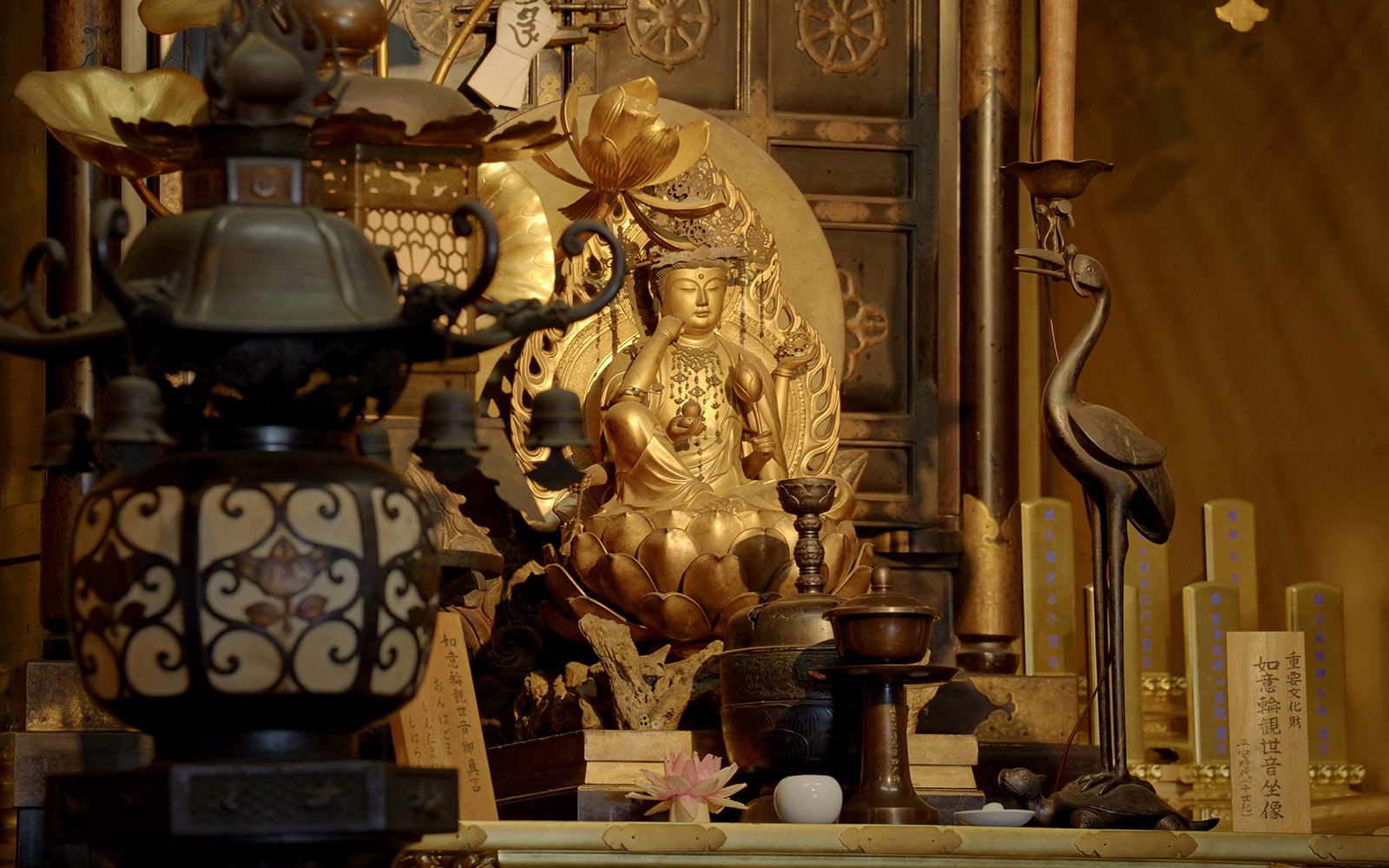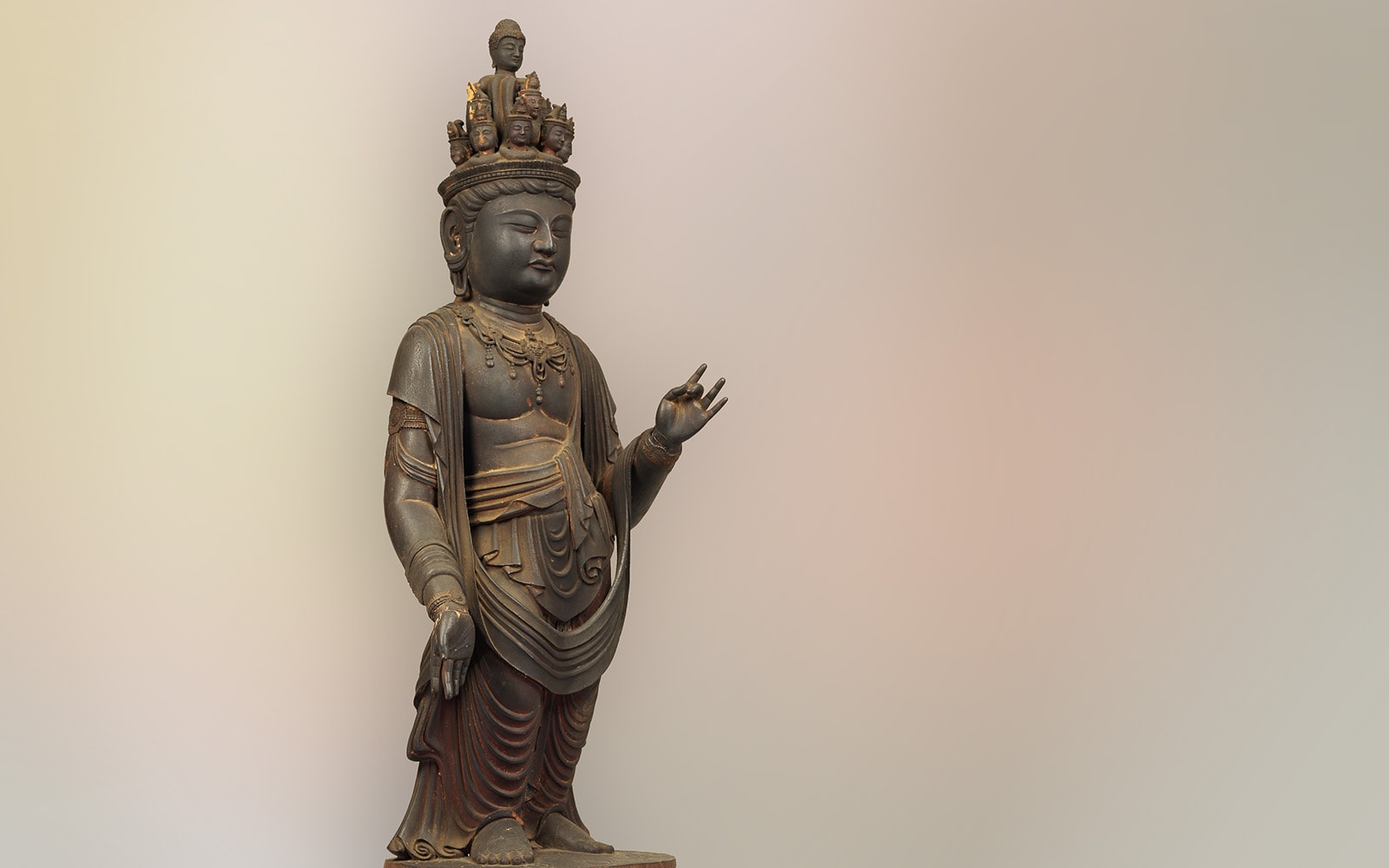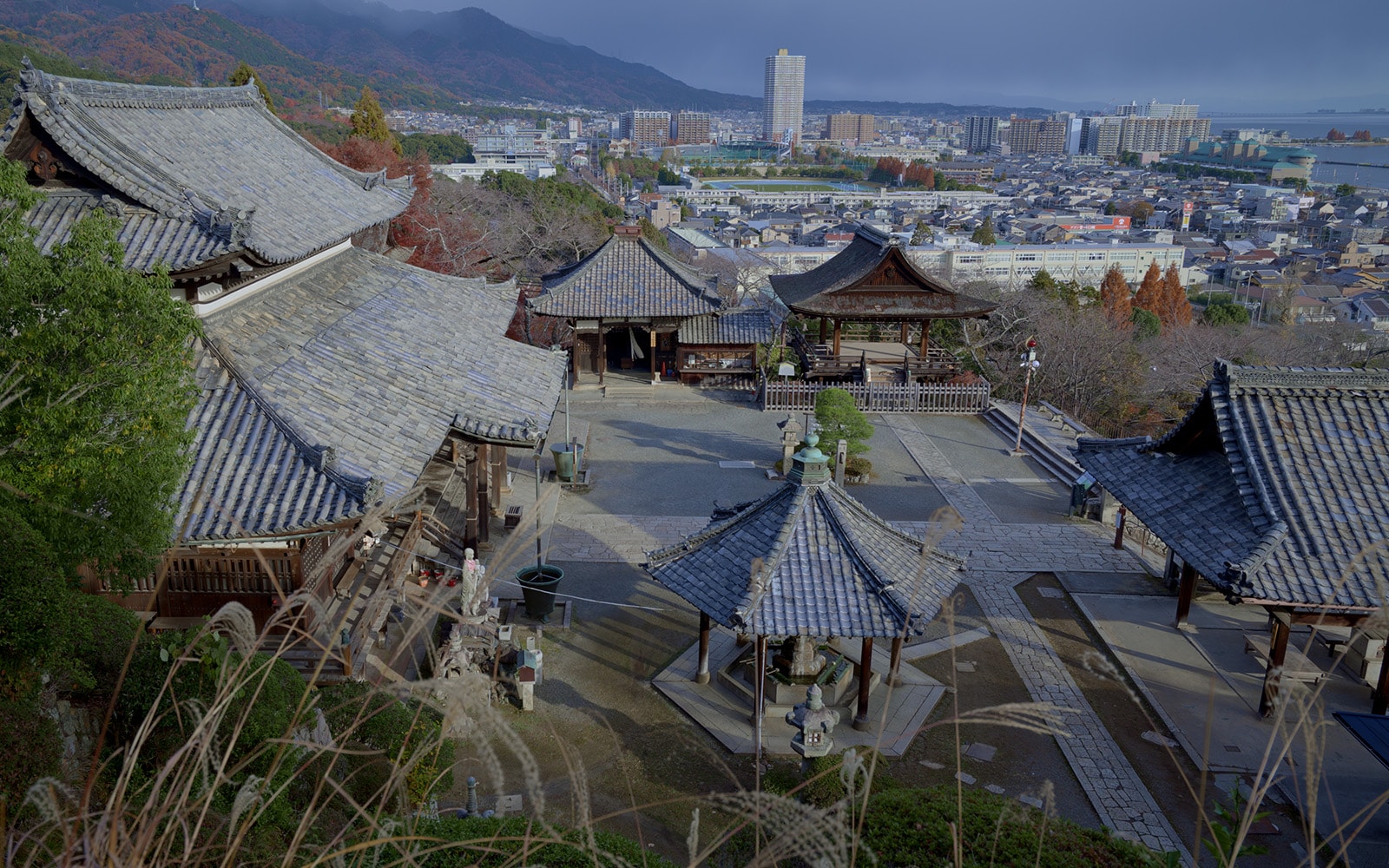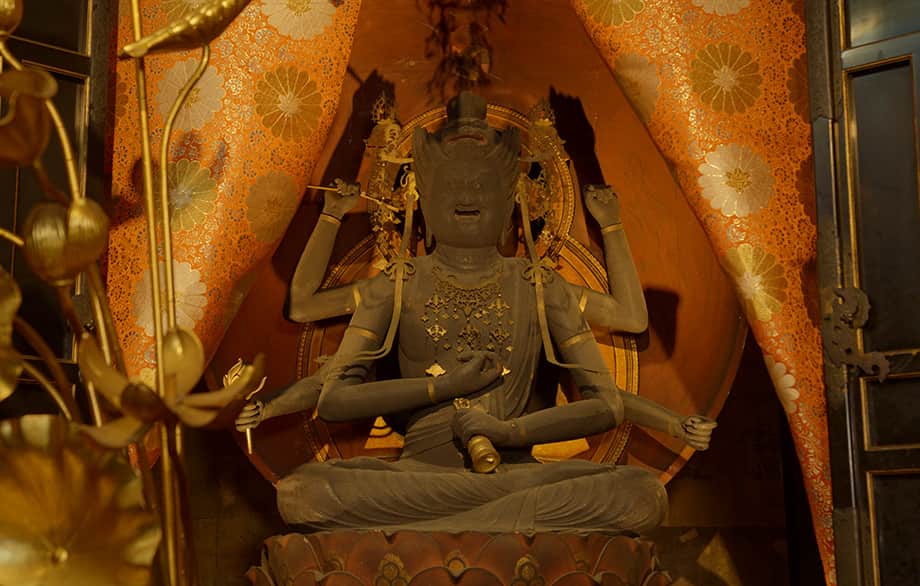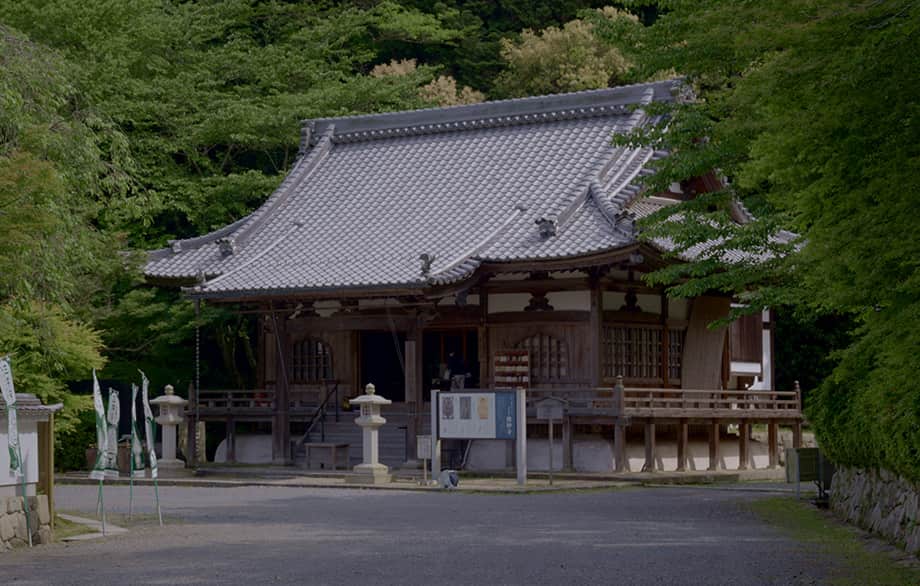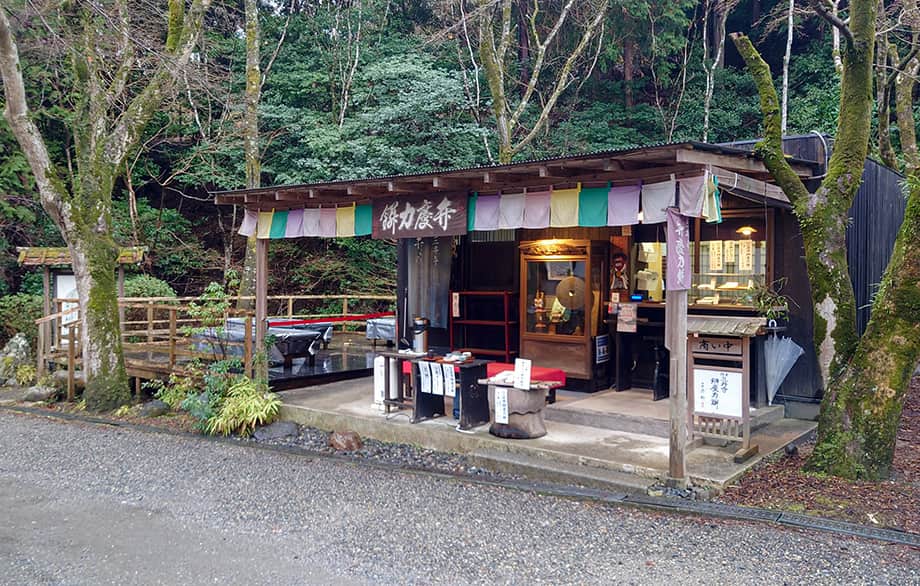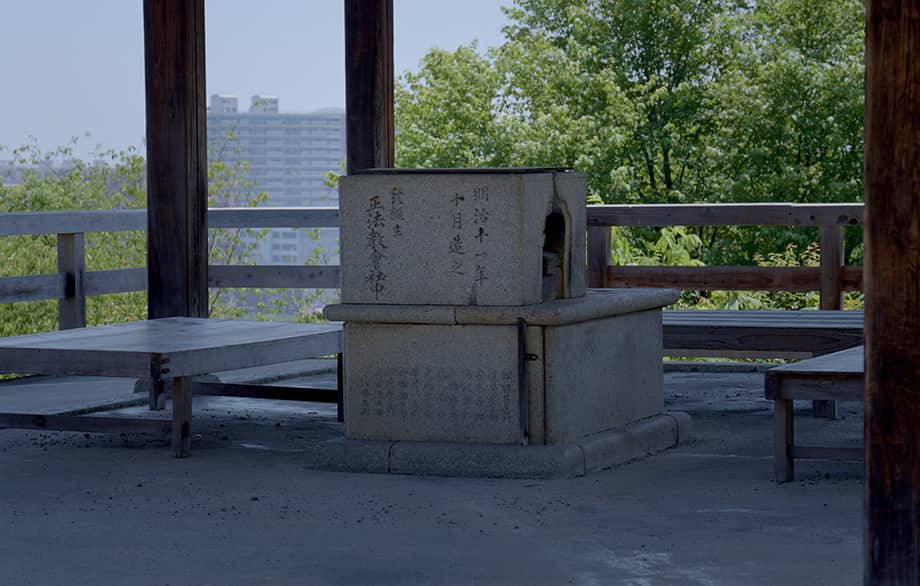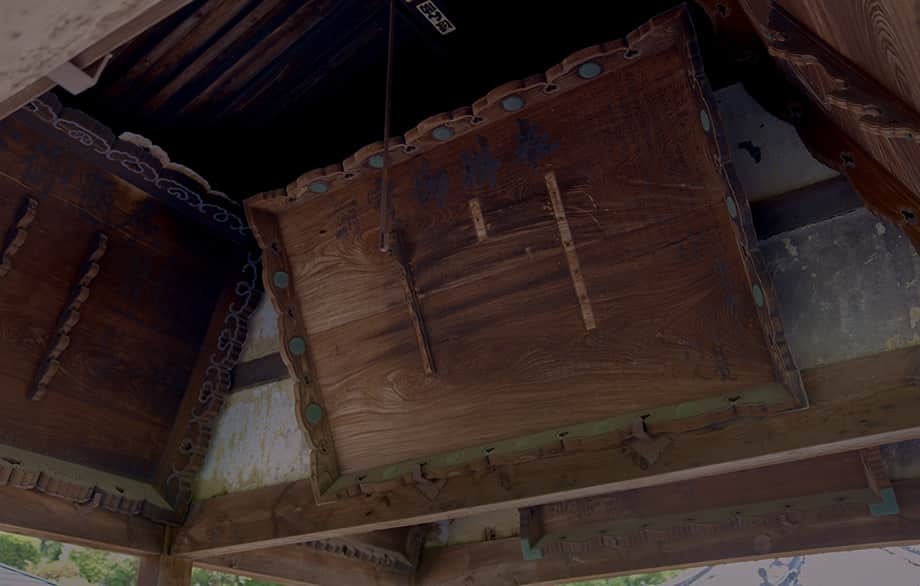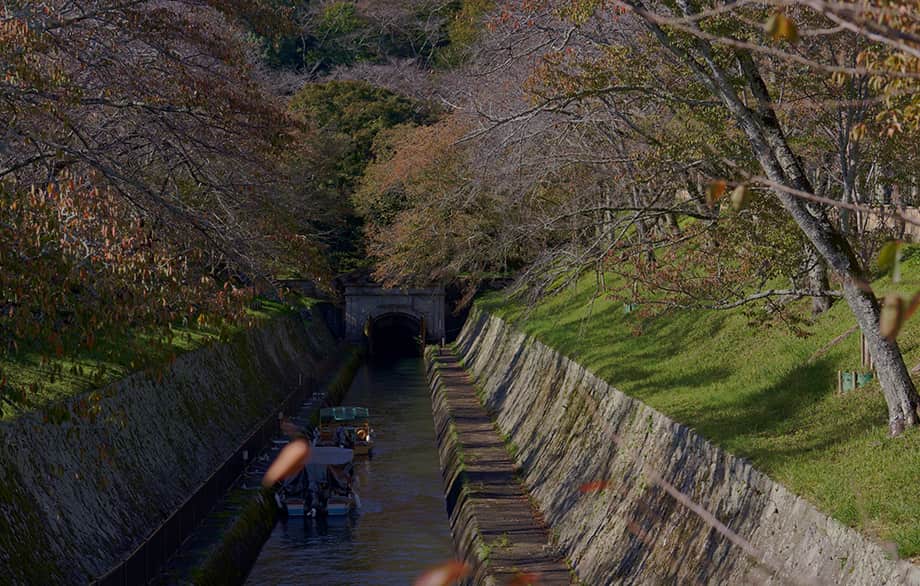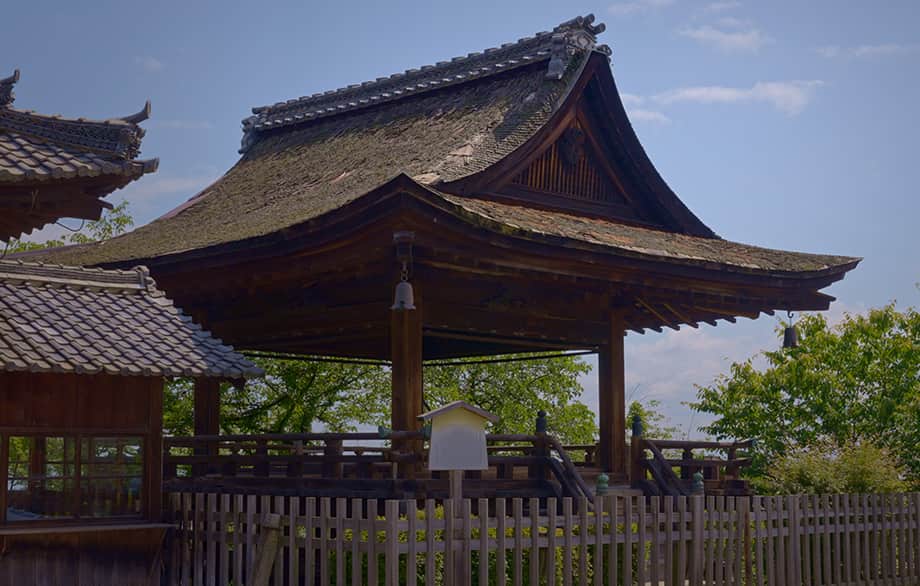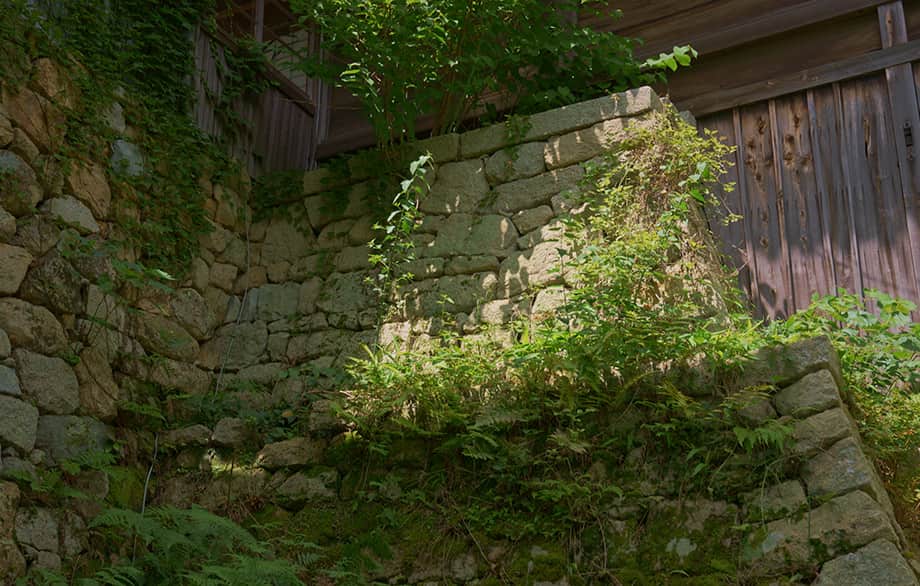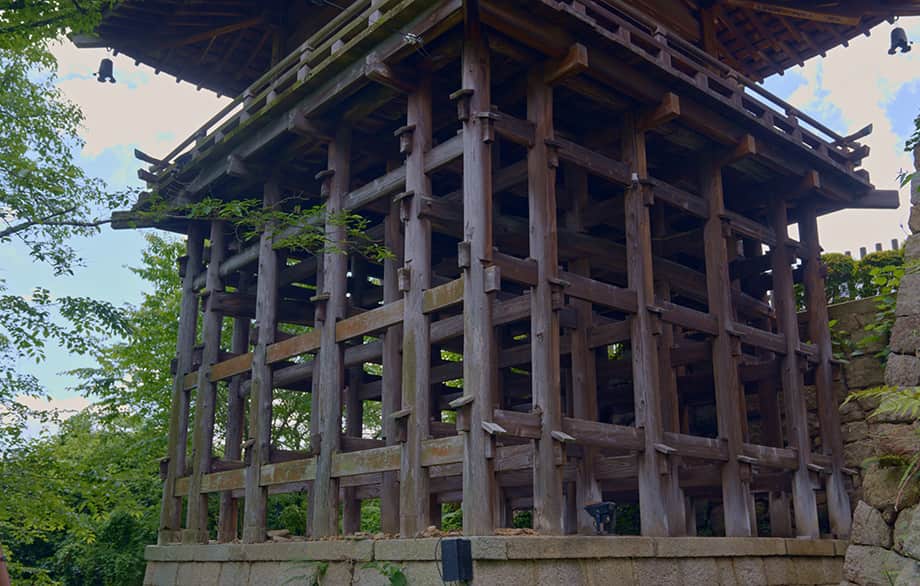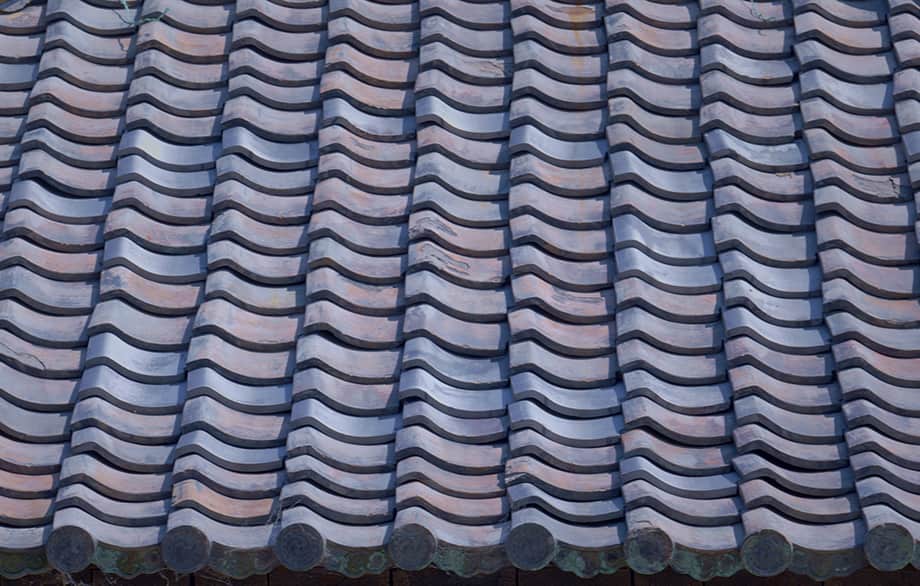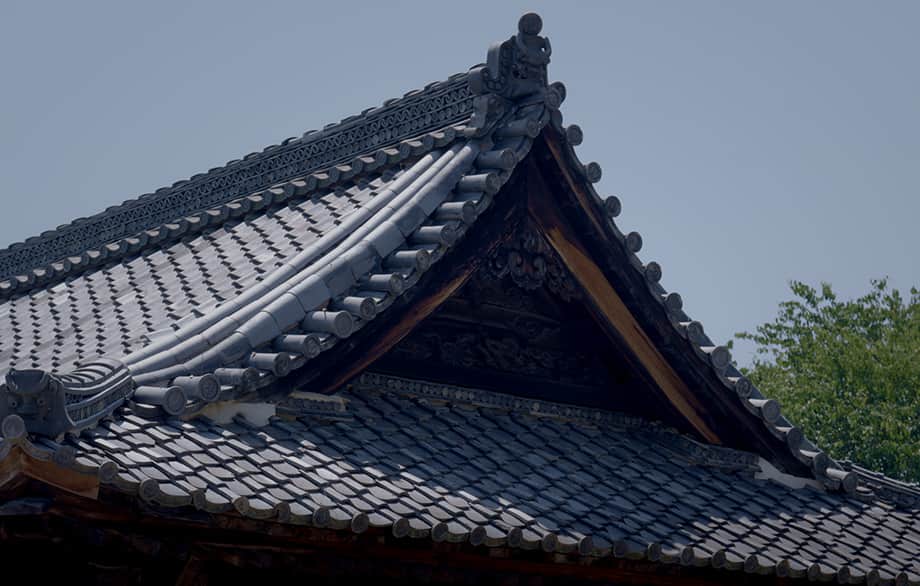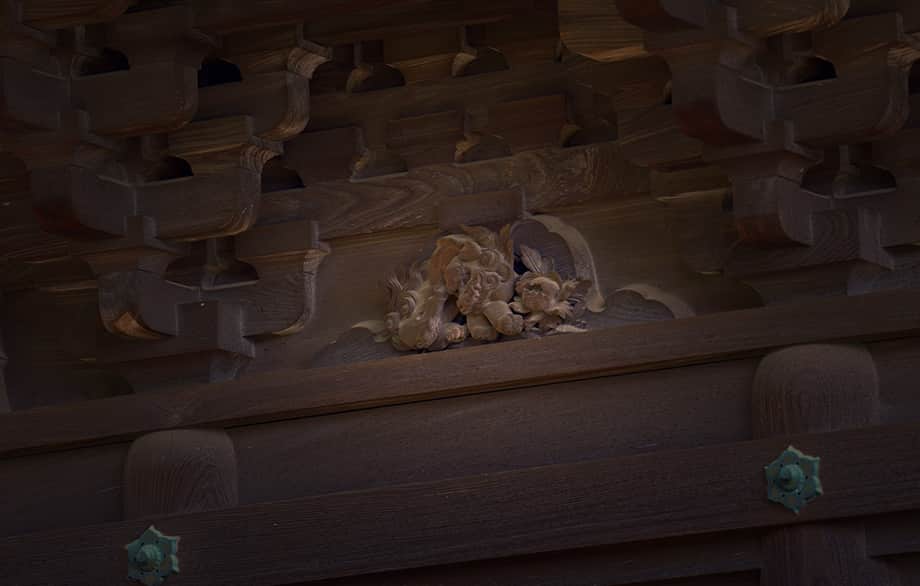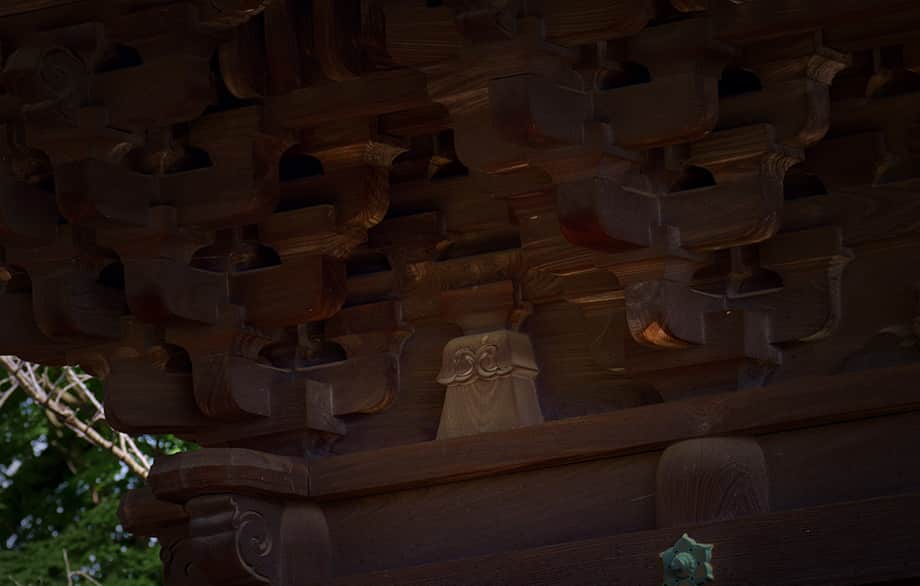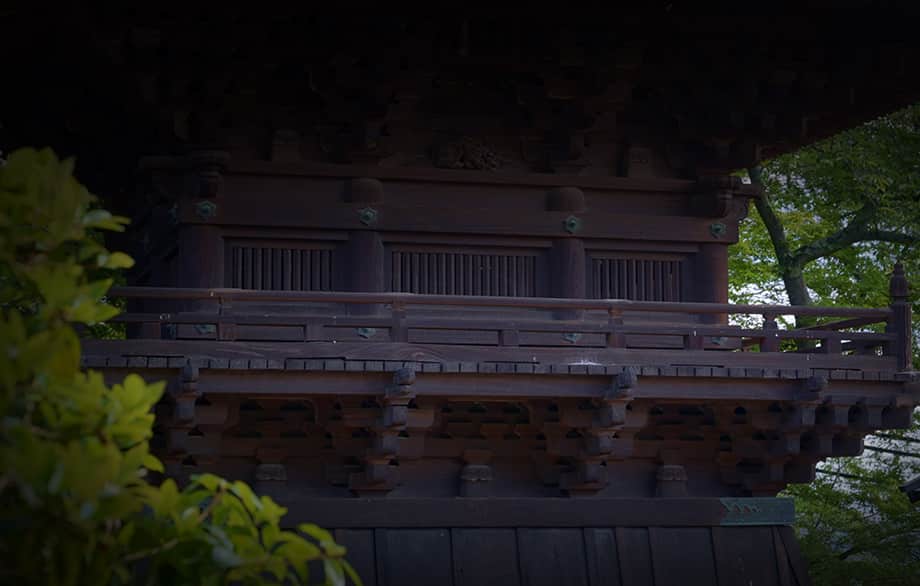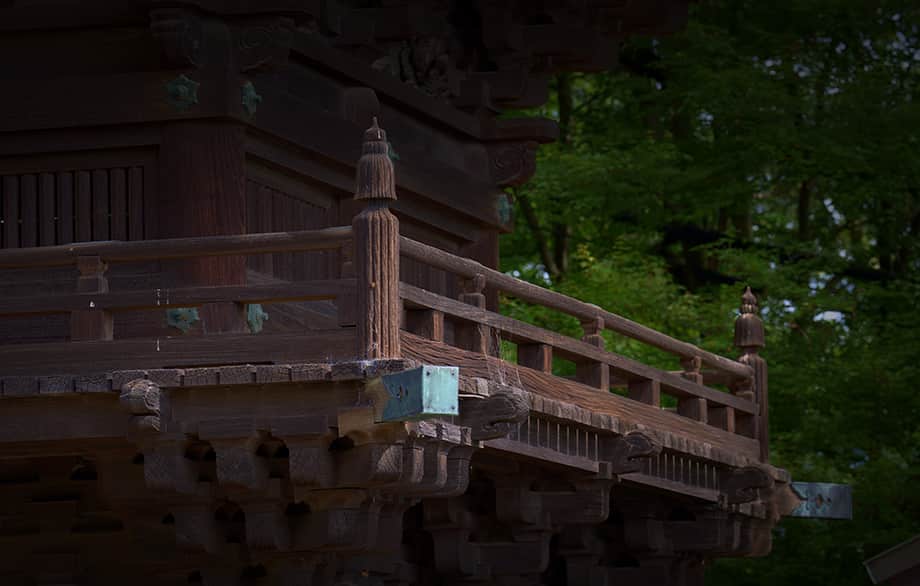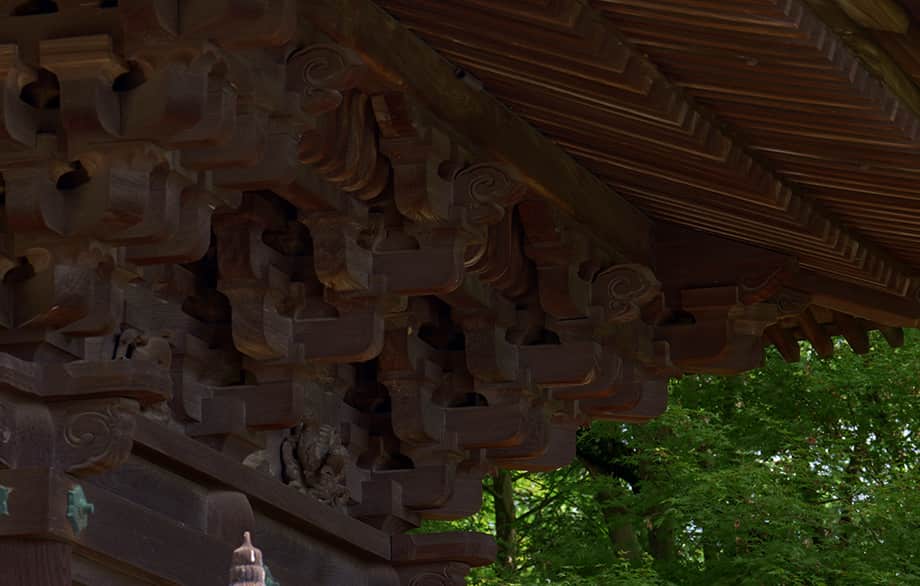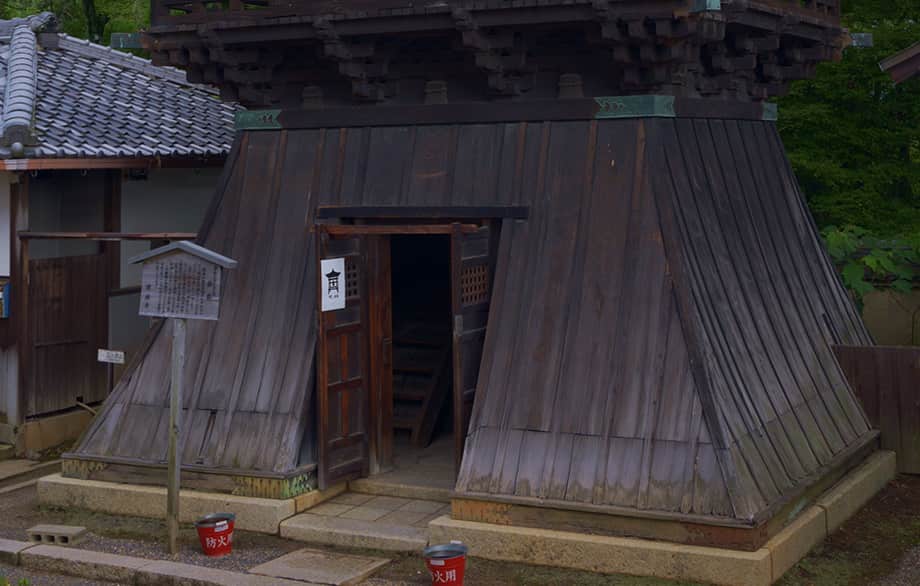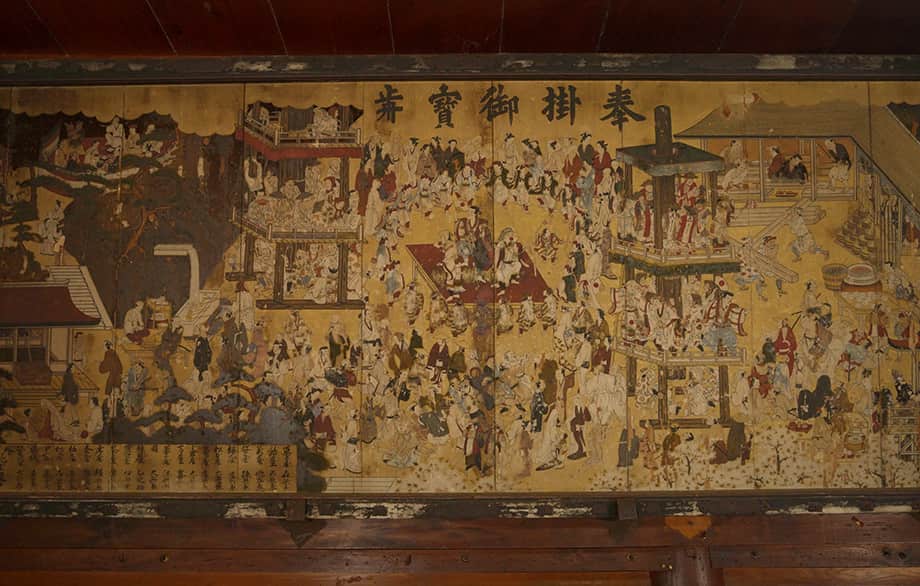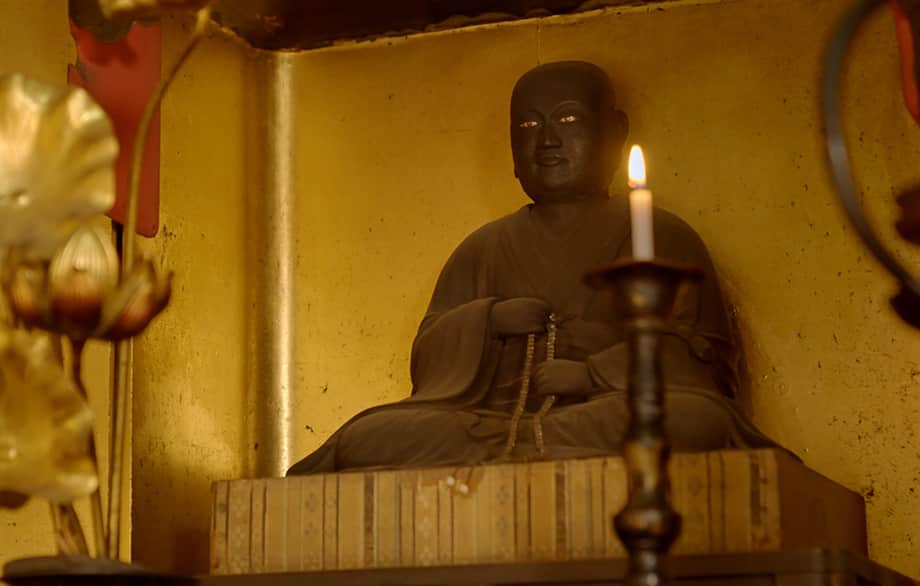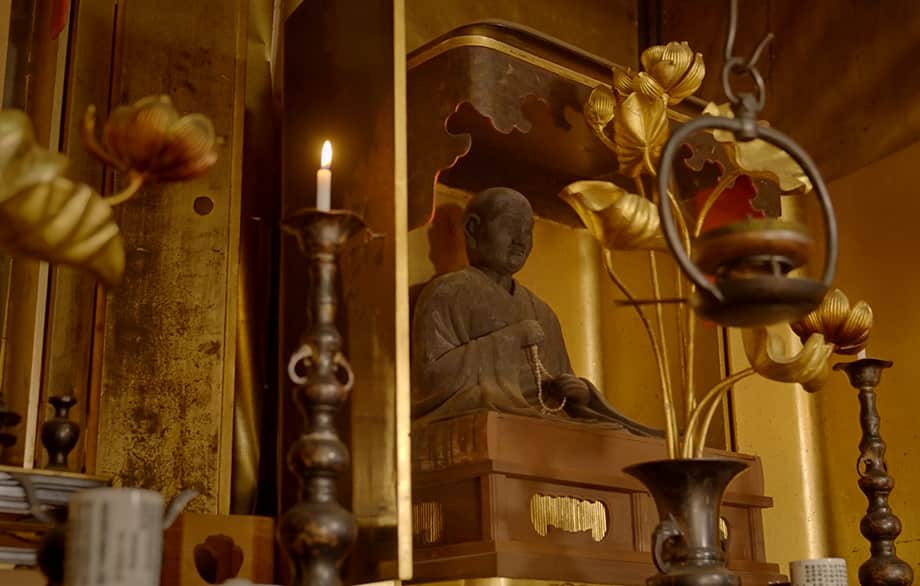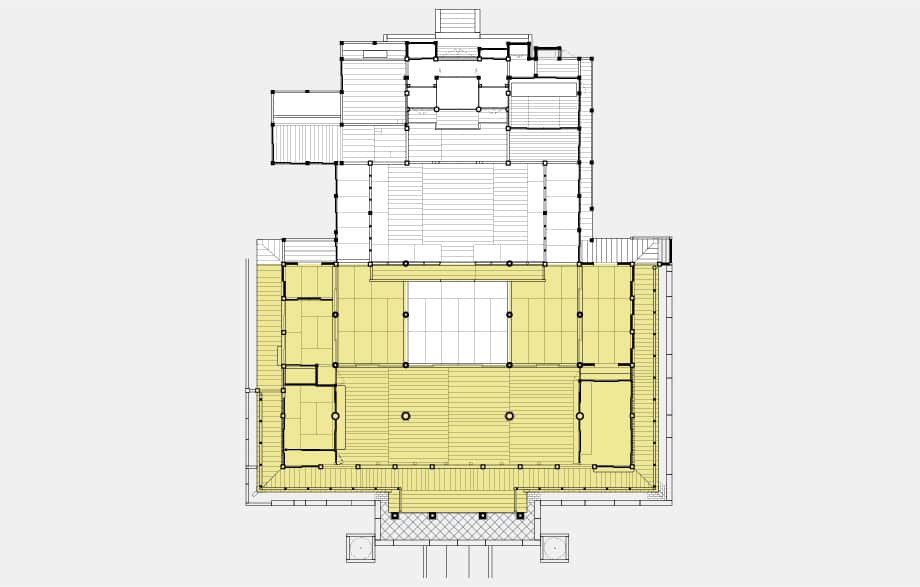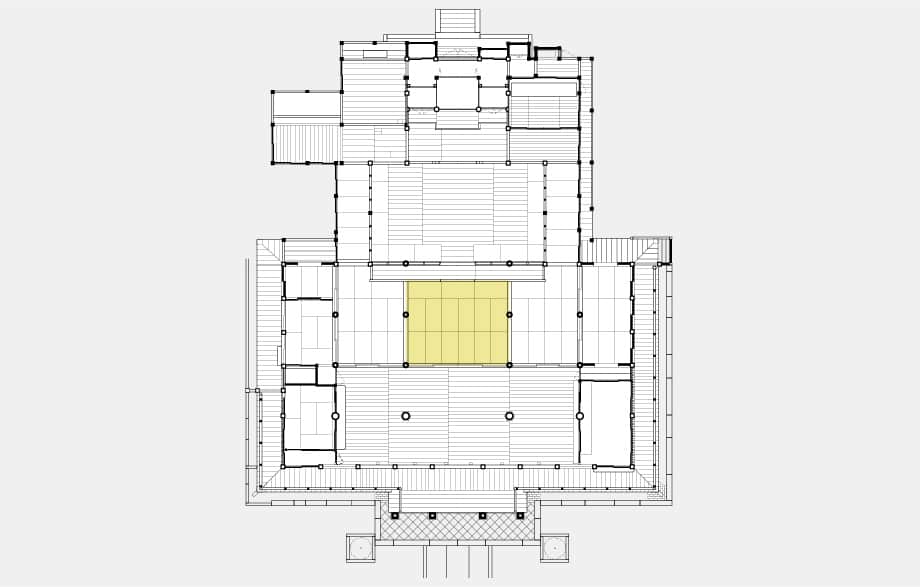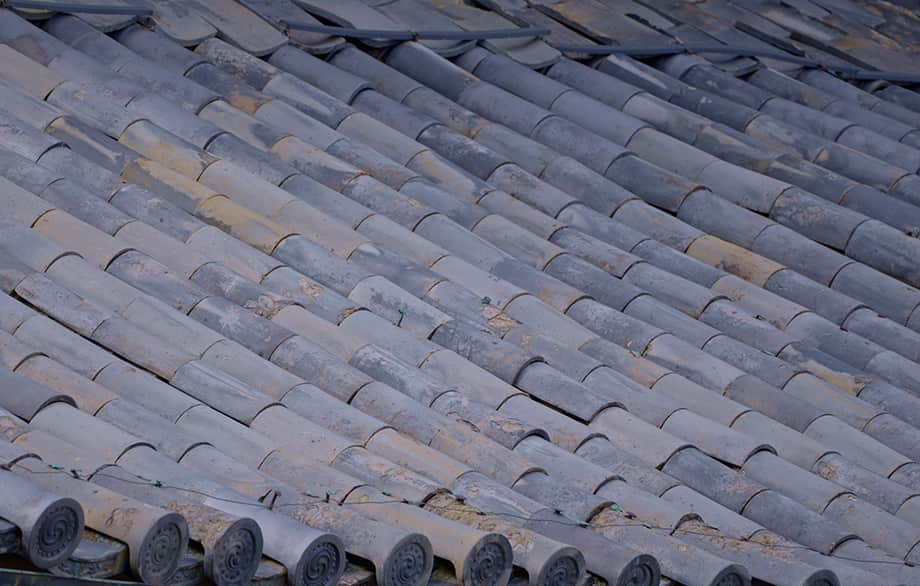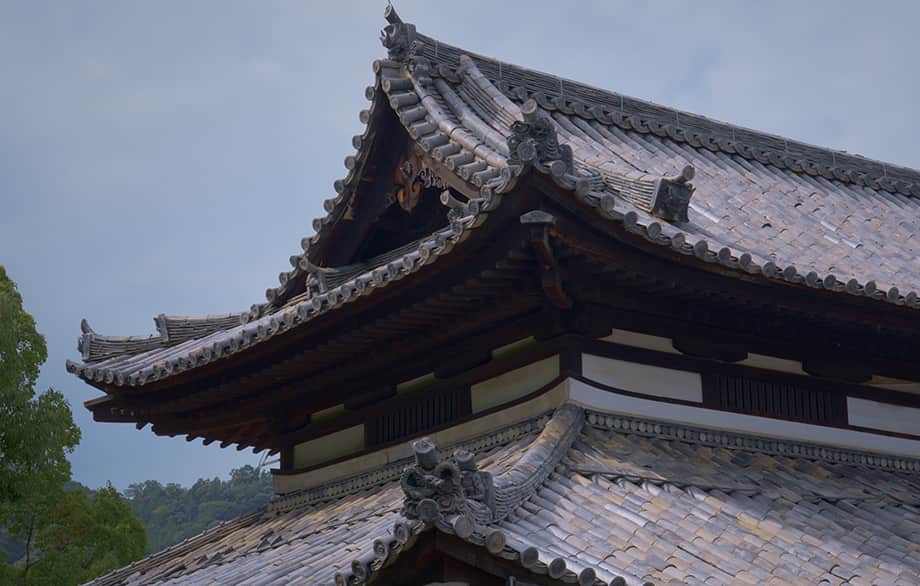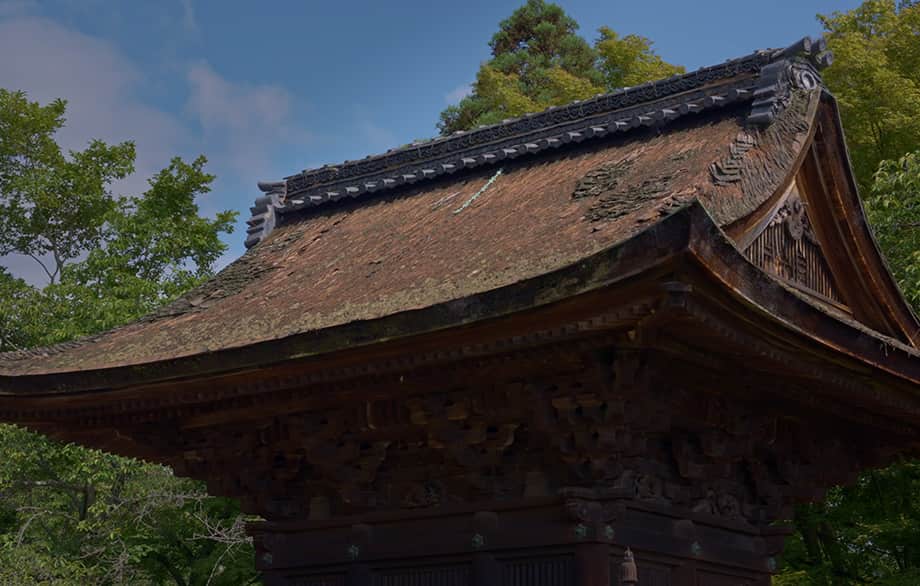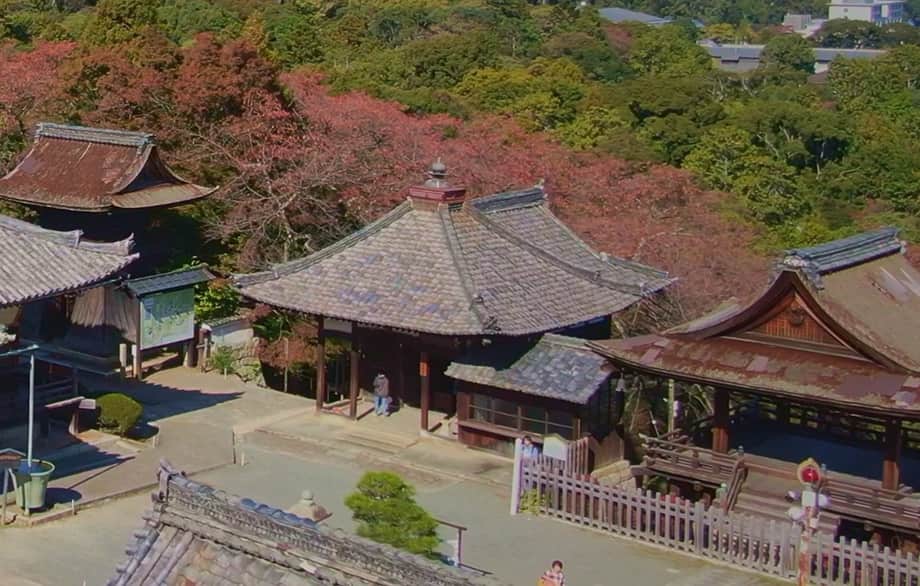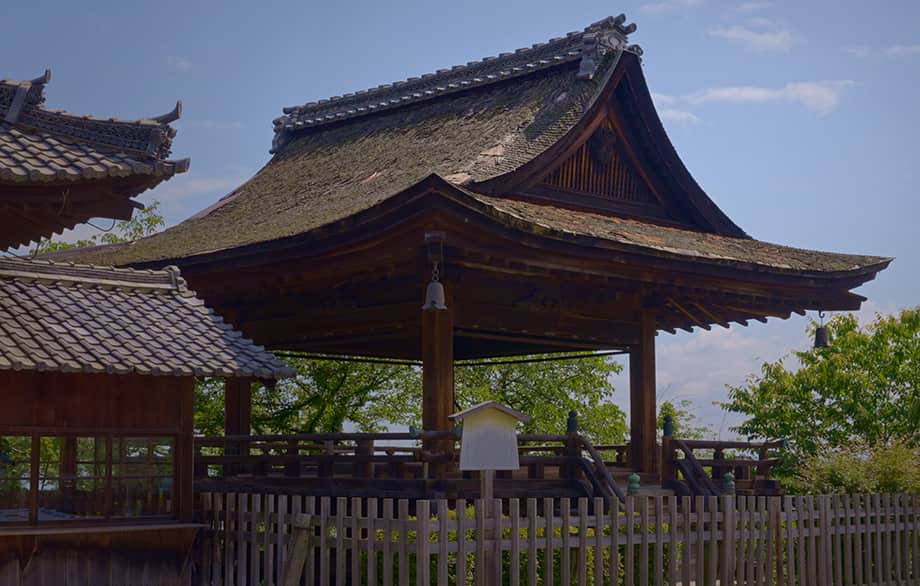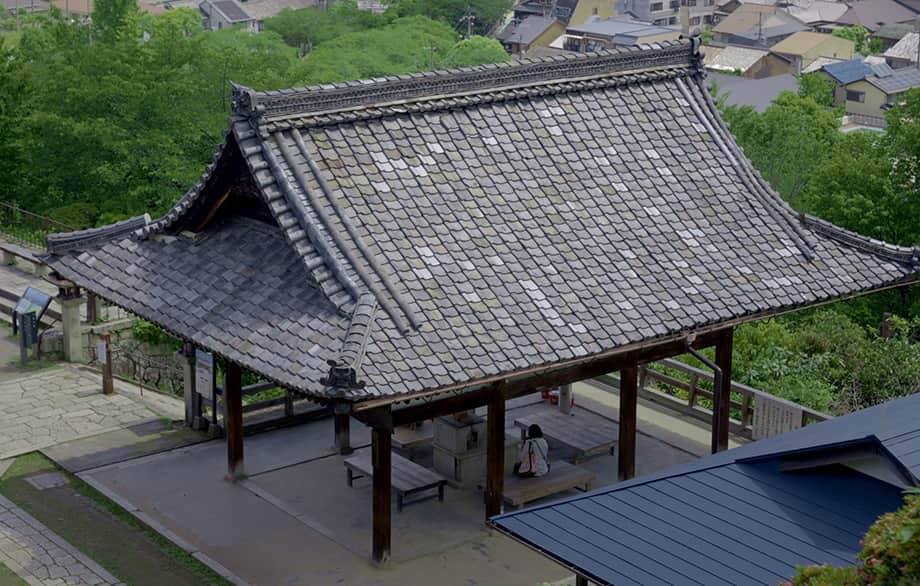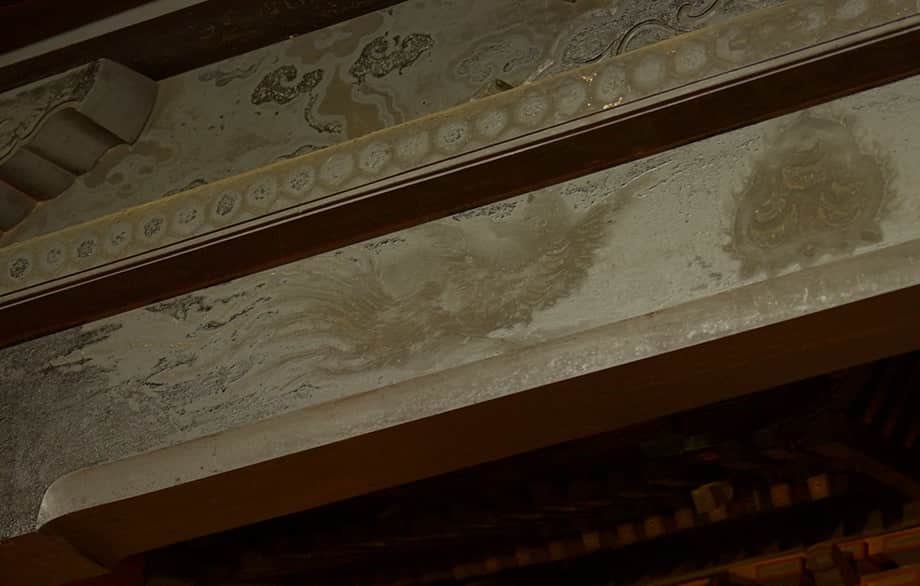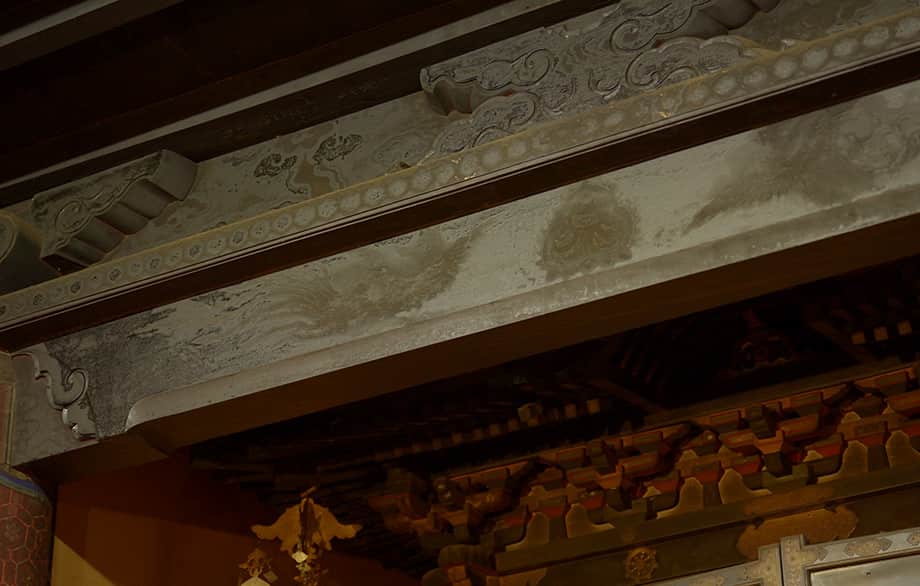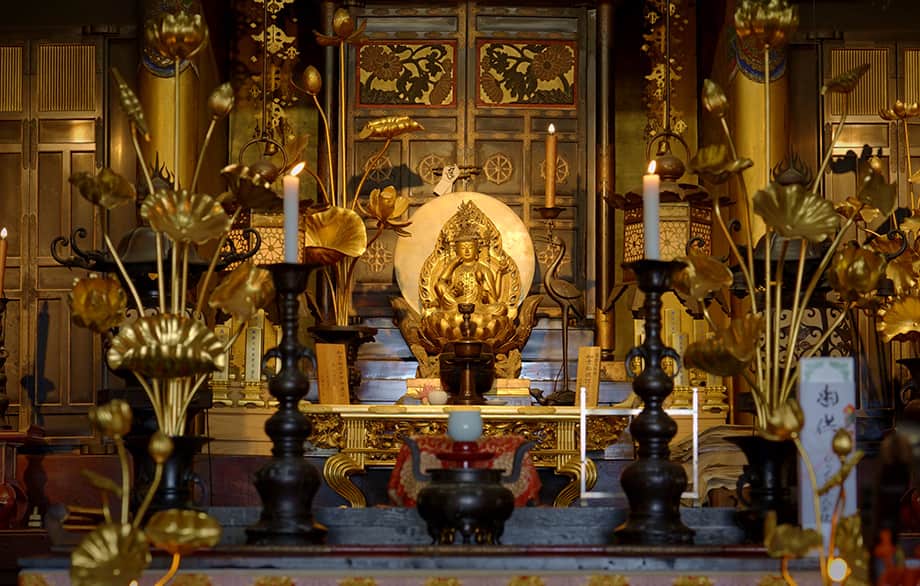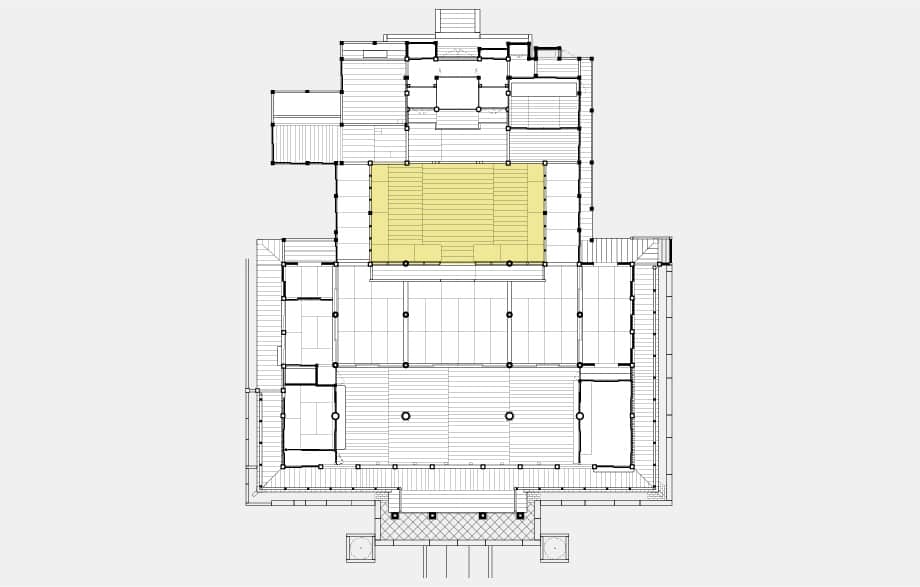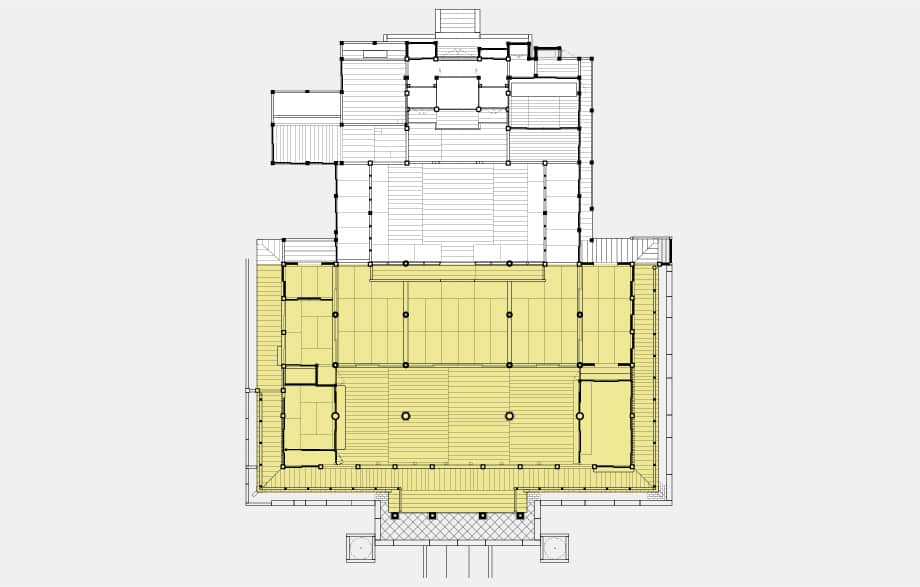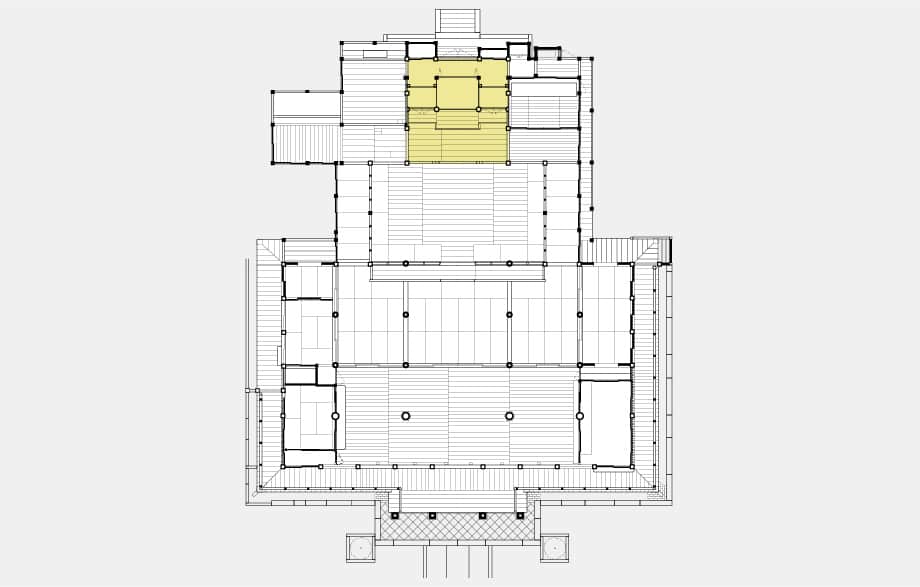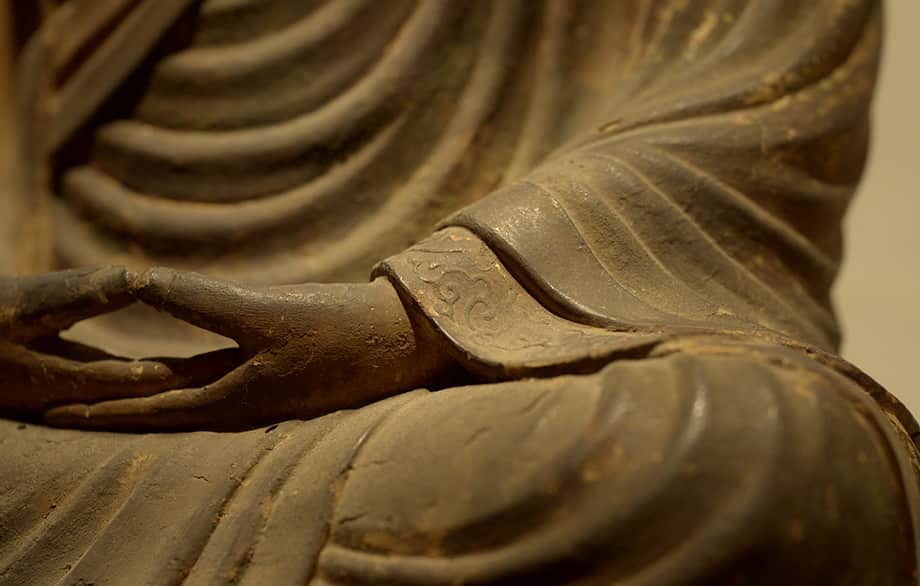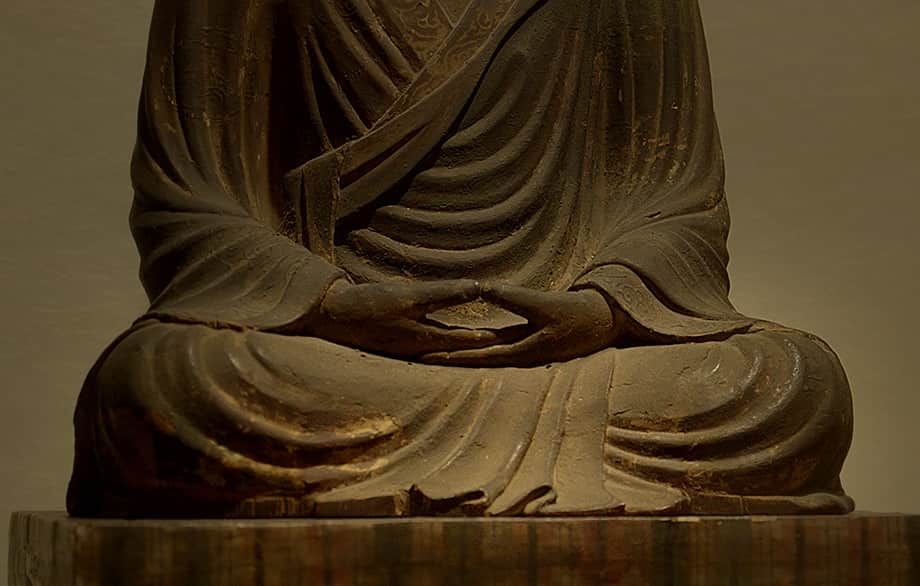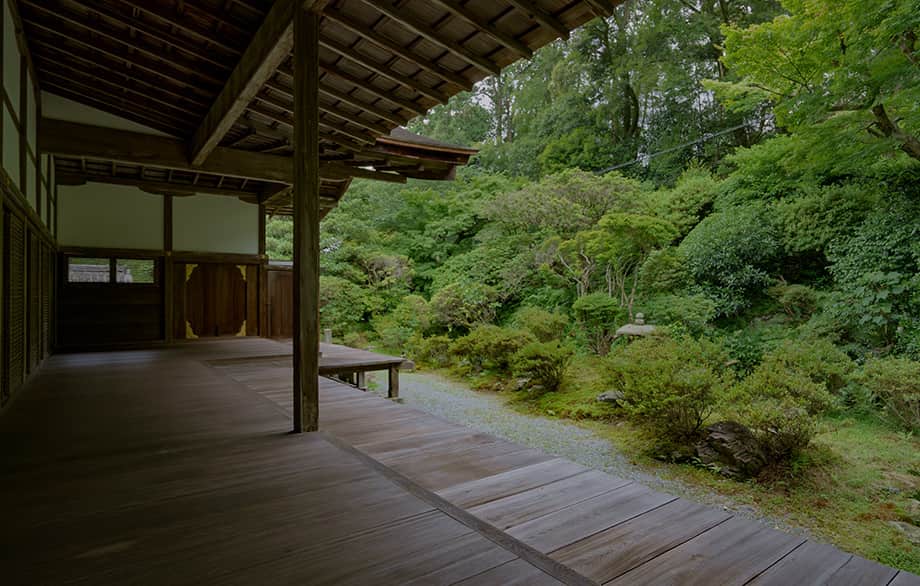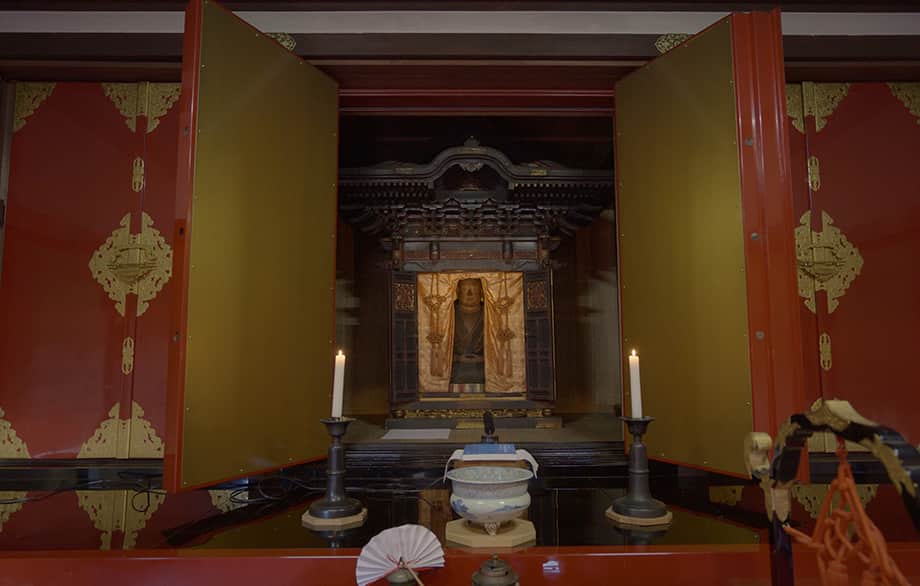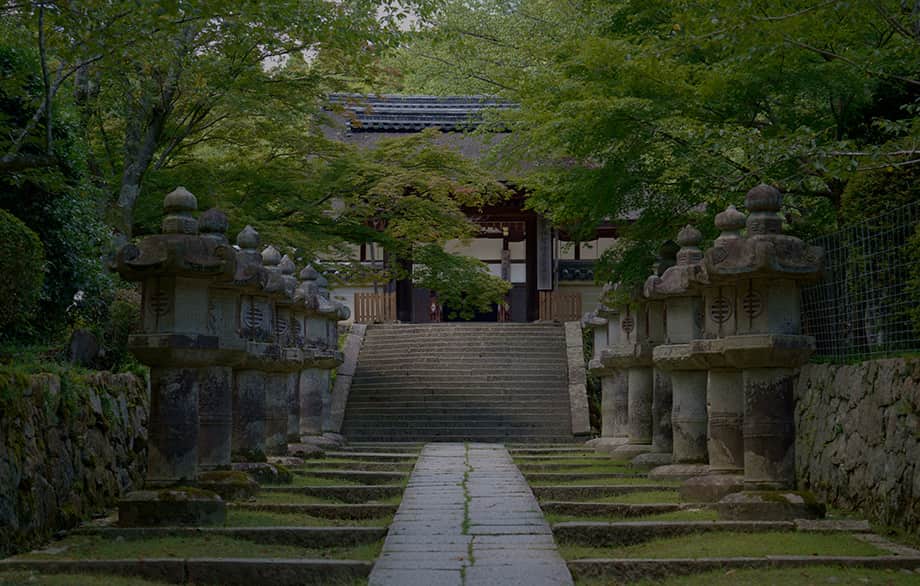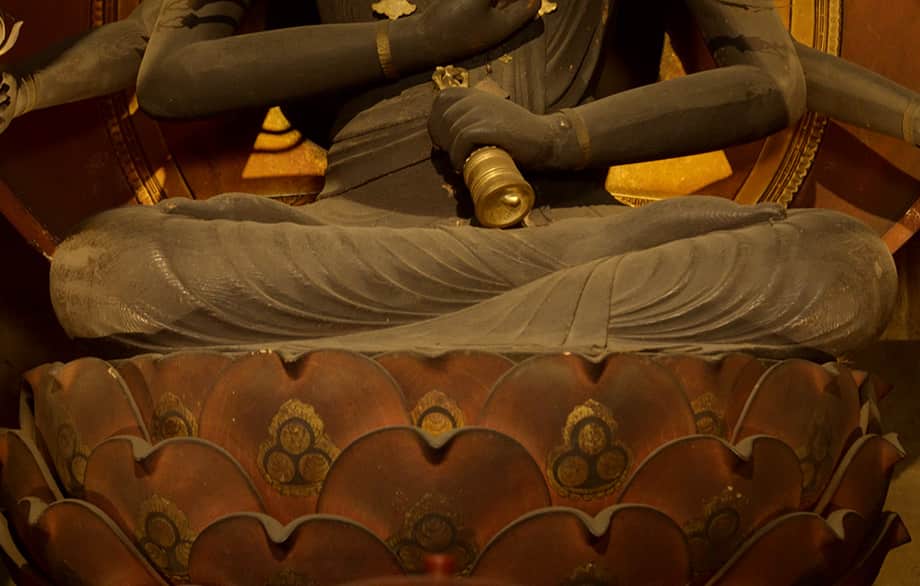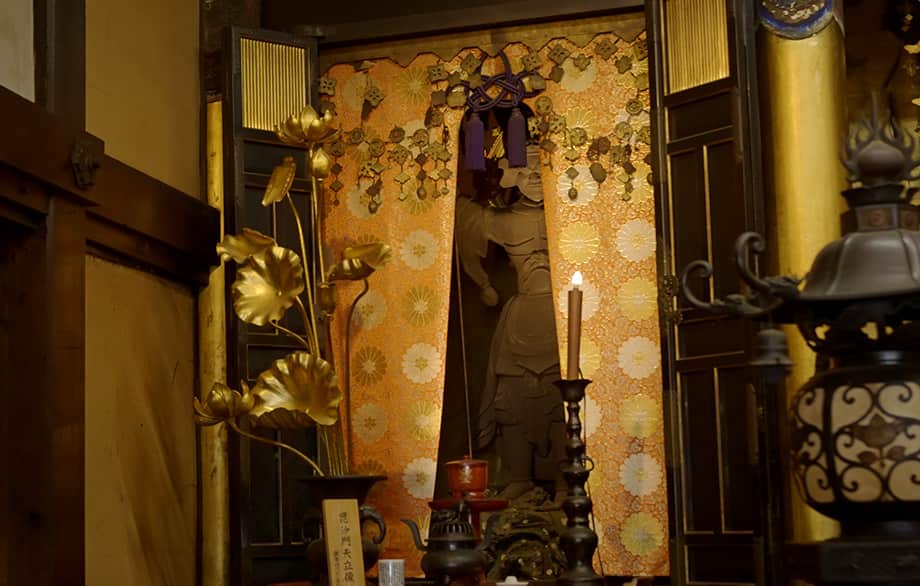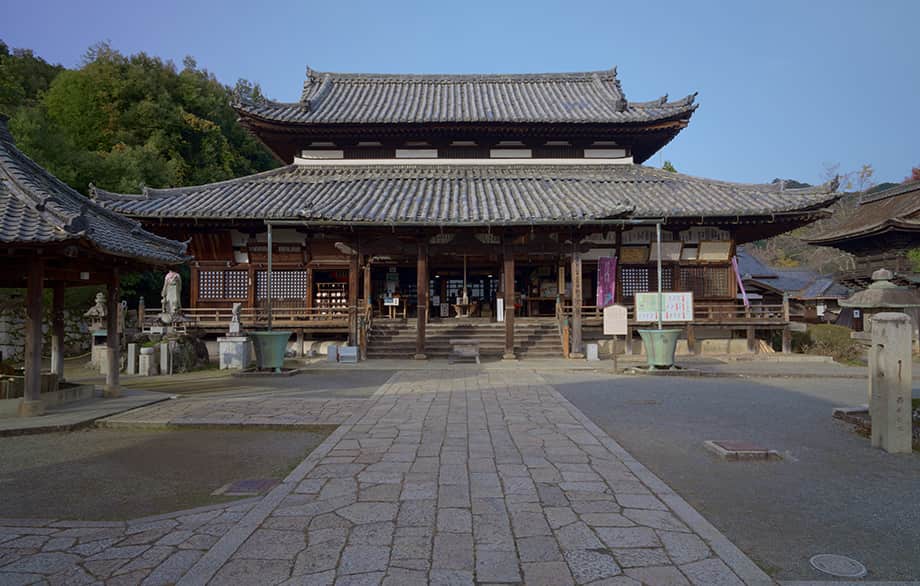Kannon Worship and Miidera's Kannondo Hall
Located in a scenic spot overlooking Lake Biwa and the city of Otsu, Miidera’s Kannondo Hall, the 14th station of the Saigoku 33 Kannon Pilgrimage, is surrounded by important cultural properties such as a bell tower, Hundred Kannon Hall, Kangetsu Butai Stage, and Emado Hall, preserving the appearance of a pilgrimage temple since the Edo period (1603–1868).
Originating in 1072 (Enkyu 4), when the secret statue of Nyoirin Kannon (an Important Cultural Property) was enshrined in the Hana-no-Tani at Mt. Nagara, praying for the recovery of Emperor Gosanjo’s (1034–1073) health, it was moved to its current location during the Bunmei era (1469–1486).
According to the Kannon Sutra, Kannon manifests in 33 forms to guide all living things to salvation, and it is believed that worship began as people hoped to receive Kannon’s blessings.
The Saigoku Kannon Pilgrimage is said to have begun with the pilgrimages of high monks from Miidera, Gyoson (1055–1135), and Kakuchu (1118–1177), who left the oldest pilgrimage records during the Heian Period (794–1185).
Currently, it consists of 33 stations and three extra temples spread over six prefectures of the Kinki region and Gifu Prefecture, and in 2019, it was recognized as a Japan Heritage as the oldest pilgrimage route in Japan.
Audio Guide
Audio Guide Playing
Note: Please use the audio guide with headphones and be careful not to disturb others.
Aizen Myoo
Bimyo-ji
Chikara-ken
Benkei Chikara Mochi
Meiji Period
1868–1912.
tie beam
A term also used to indicate the distance from the threshold to the tie beam.
stone stove
votive (ema) tablet
In ancient times, when praying to Shinto and Buddhist deities, people used to donate sacred horses, but later began offering painted wooden plaques depicting horses. Subsequently, paintings of the Chinese zodiac and other motifs started to be used.
Lake Biwa Canal
An artificial waterway extending from Lake Biwa to Kyoto, collectively used to refer to a First Canal, completed in 1890, and a Second Canal, completed in 1912. Beyond serving as a transportation route, it also facilitated hydroelectric power generation and the development of water supply and sewerage systems, significantly advancing Kyoto's urban functionality.
cypress-bark-roofed
A roof made by the method where cypress bark is fixed by bamboo nails.
statue depicted on a boat
kake-zukuri (overhanging)
An architectural style that involves securing long pillars or beams in the foundation on sites with significant elevation differences, such as cliffs, to construct the building above.
sangawara
A type of roofing with only one type of tiles, the cross-section of which is corrugated, are used. The method was invented in the Edo period (1603–1868). The tiles used to be called “simple” tiles, as they were more economical, compared to the tiles used for formal-tile roofing. Nowadays, traditional townhouses and residential buildings have this type of roofing.
pyramidal roof (hogyo-zukuri)
A type of roof where each corner of the walls of the squared building gathers in the center of the roof. Also called a tented roof.
Saigoku, Chichibu, and Bando Kannon Pilgrimages
The 33 stations of the Saigoku and Bando Pilgrimages and 34 stations of the Chichibu Pilgrimage together comprise a total of one hundred Kannon pilgrimage sites.
tail rafters
Rafters extending diagonally downward from the bracket complexes.
frog-leg strut (kaerumata)
It is a part, both sides of which widen towards the bottom with curves, like a frog opening its legs (kaeru means a frog, and mata means crotch) and is located between two connecting beams. Otherwise, its name reportedly derives from karimata, the shape of the arrowhead, the edge of which splits into two.
minozuka struts
A plectrum-shaped strut on which upper parts decorative carving of plants are applied.
ornamental devices (nakazonae)
Situated between the bracket complexes and supporting various beams, these support materials primarily function as structural elements, although they also possess strong decorative qualities.
cut-edge verandah
A type of veranda with boarded flooring. The boards are laid at right-angles to the threshold with the cut-edges exposed outward. This style is observed in wet verandas.
high railings
For fall protection, handrails are attached to the outer edge of the corridor that encircles the floor.
three-stepped
One of tokyo (a system of supporting blocks and brackets). Looking from the side, three bearing blocks are attached to the wall, making three rows of blocks.
base that flares out(flared section)
The flared lower sections of bell tower and drum tower.
foundation of castle keep
As a foundation for constructing the castle keep, it is built higher than the surrounding area and is comprised of multiple stone walls.
paneled wooden door
A paneled door with thin panels and renji latticework set into small frames in an outer door frame.
tower gate (two stories)
A two-storied gate. There is a roof only on the second floor, but no roof on the first floor, instead, koshigumi, interlocking wooden bracket sets, are formed around the perimeter.
Zen style architecture
An architectural style that was brought by Zen sect monks from China in the beginning of the Kamakura period. It is also called karayo.
bell tower
The structure within the temple grounds for hanging the temple bell.
Six prefectures of the Kinki region
Kyoto Prefecture, Osaka Prefecture, Hyogo Prefecture, Shiga Prefecture, Nara Prefecture, and Wakayama Prefecture
Kakuchu
A late Heian period (794–1185) monk. Lived from 1118 to 1177. Son of Fujiwara no Tadamichi. Studied under Zochi at Miidera. Served as preceptor when Emperor Go-Shirakawa took Buddhist vows. Held titles such as a Tendai head priest and later served as the administrator of Onjo-ji Temple. During this time, he was appointed as great high priest (daisojo). Also known as a poet.
Gyoson
A Heian period (794–1185) monk and poet and the great-grandson of Emperor Sanjo. He lived from 1057 to 1135. He was a son of Associate Counselor Minamoto no Motohira and entered the priesthood at the age of 12, joining Miidera Temple. After undertaking ascetic training at Mt. Omine, he received the rank of initiate from Raigo at the age of 25. His reputation grew as the efficacy of his prayers was celebrated, leading him to become an guardian monk of Emperor Toba. He was appointed as the administrator and high priest of Onjo-ji Temple. Renowned for his calligraphy, biwa playing, and waka poetry, his works created during his training at Mt. Omine were esteemed by later generations as a precursor to the poetic style of Saigyo.
Heian period
The Heian period lasted for approximately 400 years between the transfer of the capital by Emperor Kanmu in 794 and the foundation of the Kamakura Shogunate in 1185, and the central administration was in Heian-kyo (present-day Kyoto). Generally, the period is divided into three sections: the Early, Mid- and Late Heian periods. In other words, the period of reviving the political system based on Ritsuryo codes, the regency period and the Insei period (governed by a retired emperor), respectively. (The end of the Late Heian period was ruled by the Taira clan.) Also called the period of Heian imperial court.
Kannon Sutra
Another name for a chapter of the Lotus Sutra, specifically "The Chant of Lotus Sutra No. 25." It speaks of the power of Kannon and the belief that if one trusts in her compassion and recites her name, she will save them.
Emperor Gosanjo
Emperor Gosanjo (1034–1073) was the emperor who reigned in the mid-Heian period. The second prince of Emperor Gosuzaku. His name was Takahito. He suppressed the Fujiwara clan’s arbitrary use of power and founded the record office to organize manors in order to end the political abuse. (Reigned 1068–1072)
Edo period
The name of the period that lasted approximately 260 years from when Tokugawa Ieyasu founded the shogunate in 1603 after winning the Battle of Sekigahara in 1600 until the restoration of imperial rule by Tokugawa Yoshinobu in 1867. Also called the Tokugawa period.
Lake Biwa
This scenic fault lake is located in the center of Shiga Prefecture. It has the largest surface area of 670.3 ㎢ in Japan. The surface elevation is 85 meters, and the maximum depth is 104 meters. Its water has a great deal of potential for waterworks, irrigation, transportation, power generation, and fisheries, as a wide area receives water. There are some islands such as Oki-shima, Chikubu-shima, Take-shima, and Okinoshiraishi. Also called the sea of Omi and Nionoumi.
Ishizuki-no-Zu
Rennyo Shonin Statue
Shinran Shonin Statue
outer sanctuary
inner sanctuary
pent roof
In shrine and temple architecture, a structure with a roof that protrudes over the front steps. It allows the priest and worshippers to conduct ceremonies or pay respects from the front of the hall.
tiled roof (hongawarabuki)
A roofing method with two types of roof tiles, concaved roof tiles and semi-cylindrical convex tiles, are laid alternatively. This historical method has been used since the Asukadera Temple was built. It was the first full-scale temple in Japan and was built at the end of the sixth century.
hip-and-gable style (irimoya-zukuri)
A gable (kirizuma-zukuri) is right above the core and a hipped roof are attached to the four sides on the lower part of the gable. (hip-and-gable roof construction)
Genroku era
The Genroku era is a term spanning the mid-Edo period (1688–1704) during the reign of the fifth shogun Tokugawa Tsunayoshi (1680–1709). It represented a time of peak authority for the shogunate, characterized by a policy of civilian government. This period saw advancements in agriculture and commerce, along with the rise of townspeople. A refreshing spirit permeated the realms of scholarship and culture, producing the opulent Genroku culture.
auspicious birds
arched beams (kouryou)
Beams that curve upwards, reminiscent of a rainbow.
decorative metal fittings and paintings reminiscent of gold brocade (kinran-maki)
A historical period. It refers to the time from 1568, when Oda Nobunaga entered Kyoto with Ashikaga Yoshiaki, to 1598, when Toyotomi Hideyoshi passed away, or alternatively until 1603, when Tokugawa Ieyasu was appointed as the Shogun and established the shogunate.
dais
A platform used for enshrining statues of Buddhas and other figures.
ai-no-ma
The area where buildings are connected and unified under a single roof.
Raido Hall
The place that accommodates worshippers.
Shodo Hall
The place where the principal object of worship is enshrined.
statue containing the remains of Daishi (Okotsu Daishi)
The seated statue of Chisho Daishi, a National Treasure. After the passing of the Daishi, his image was replicated, and his remains were enshrined within the statue. Even now, in accordance with the Daishi's final wishes, it is enshrined as a sacred hidden Buddha in the depths of the Toin's Daishido Hall.
Kamakura period
The name of the period that lasted for approximately 150 years from when Minamoto no Yoritomo founded the shogunate in Kamakura until Hojo Takatoki’s death in 1333.
arabesque patterns
The term refers to a plant motif that is stylized to depict the shapes of leaves, stems, or climbing vines intertwining or extending. Usually it does not refer to a particular species.
single-block wood carving (ichiboku-zukuri)
A wood carving technique where the main parts of the head and body of the statue are carved from a single piece of material.
edge of hem
Kangakuin School
Chuson Daishi Statue
Toin
Chisho Daishi
Born in Zentsuji City, Kagawa Prefecture (present-day) in 814. His father was from the Wake clan, and his mother was a niece of Kukai. At the age of 15, he went to Mt. Hiei and became a disciple of Gishin (778–833). At the age of 40, he went to Tang China in 853, learned Tendai studies and esoteric Buddhism in Mt. Tendai and Chang’an. Later, he disseminated what he had studied after returning to Japan. He stored the scriptures brought back from Tang China in the Toin Hall and took office as the first chief administrator. He then established a foundation to promote Miidera Temple to the Jimon branch main temple later by appointing Miidera Temple as a Tendai sect branch temple. He was appointed as the fifth Tendai head priest in 868 and dedicated himself to the prosperity of Buddhism for an impressive 23 years. He passed away on October 29, 891.
garment
lion head crown
engraved eyes (chogan)
A technique seen in some wooden statues where the eyes are engraved.
yosegi-zukuri
A wood sculpting technique in which multiple pieces of wood are combined to create the head and torso of a statue. This method involves hollowing out the interior to reduce weight, allowing for the construction of large statues with minimal wood, among other advantages. It is a technique unique to Japan and was perfected from the mid to late Heian period (794–1185).
Bishamonten
One of the Four Heavenly Kings and also one of the twelve devas. It is said that he lives halfway down the north of Mount Sumeru and protects the northern direction with Yaksha and Rakshasa. He is also reportedly the deity who protects treasures. He is portrayed as a furious armor-clad warlord holding a pagoda in one hand and a spear or treasure club in the other. One of the Seven Deities of Good Fortune in Japan. He is also called Tamonten, and this name is normally used to enumerate the Four Heavenly Kings. There is also another name for him, Kubira (Kubera in Sanskrit), who is the lord of riches in Hindu mythology.
Nyoirin Kannon Statue
The statue has one face and six arms. It is made with a technique, yosegi-zukuri (assembled with pieces of wood), with carved eyes and is covered in gold leaf on Japanese lacquer. Its appearance with his rounded face tilted to the right, the back of the fingers of one right hand on his cheek and his right knee standing is graceful and beautiful. A large openwork crown on his head and necklaces were added later.
Kannondo Hall
Saigoku 33 Kannon Pilgrimage
The pilgrimage route to worship Kannon by visiting 33 Buddhist temples located in Gifu Prefecture and other six prefectures in Kinki Region. It is the oldest pilgrimage route and many worshippers visit it. The oldest records are the pilgrimage records written in “Jimon-Koso-ki” (the records of Jimon school’s high-grade priests) by Gyoson (1055–1135) and Kakuchu (1118–1177). Both were priests in Miidera Temple in the Heian period (794–1185), and Miidera Temple greatly influenced the forming of the Saigoku 33 Kannon Pilgrimage. The Saigoku 33 Kannon Pilgrimage became popular among people the Muromachi period (1336–1573) onward. Other pilgrimage routes called copied versions of the Saigoku 33 Kannon pilgrimage such as the Bando 33 Kannon Pilgrimage in the Kanto Region and the Chichibu 34 Kannon Pilgrimage were established all over the country. It was designated as a Japan Heritage site in 2019 as the “Saigoku 33 Kannon Pilgrimage—a journey of Japan’s end-of-life activity with 1300 years of history”.


